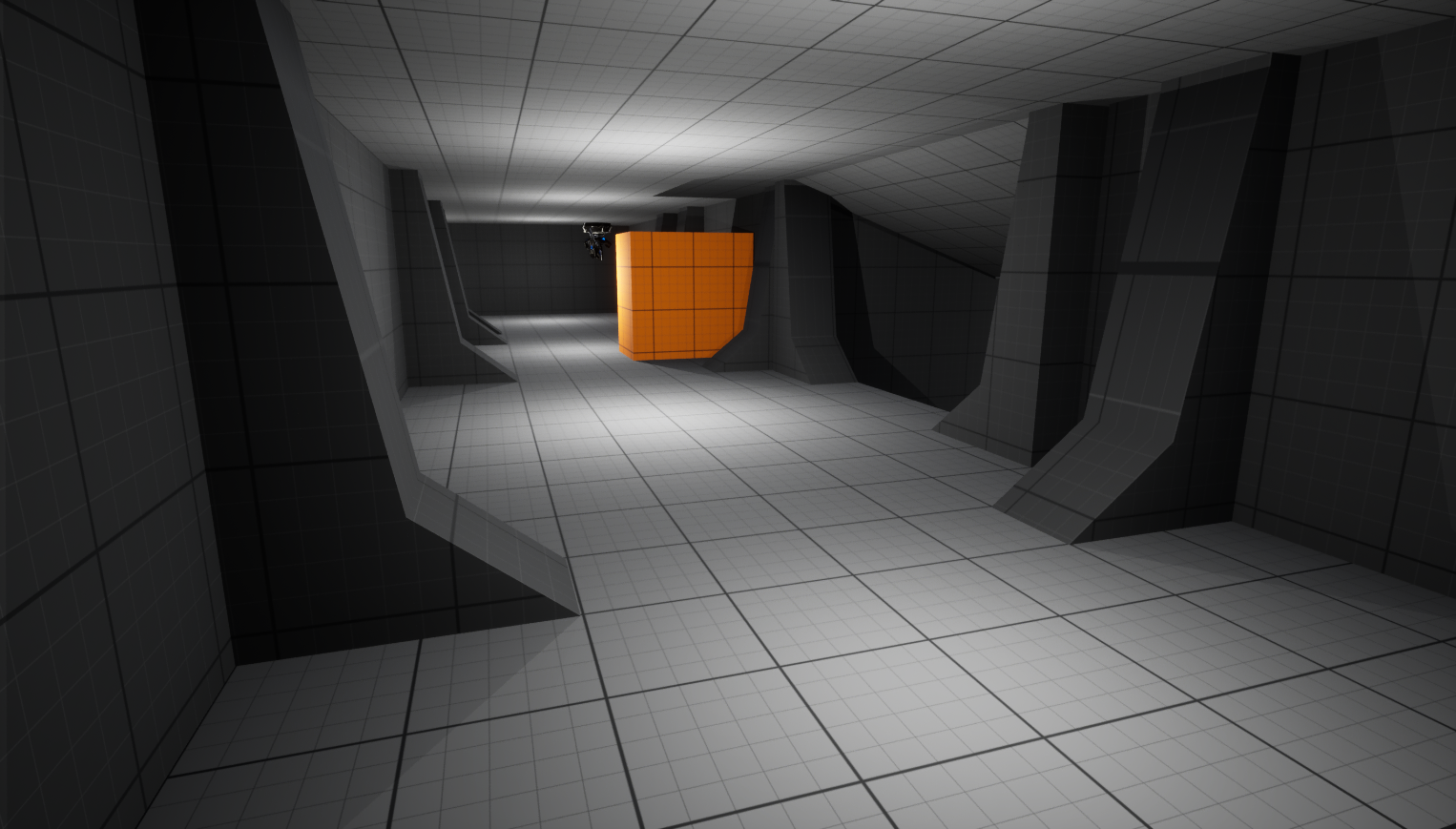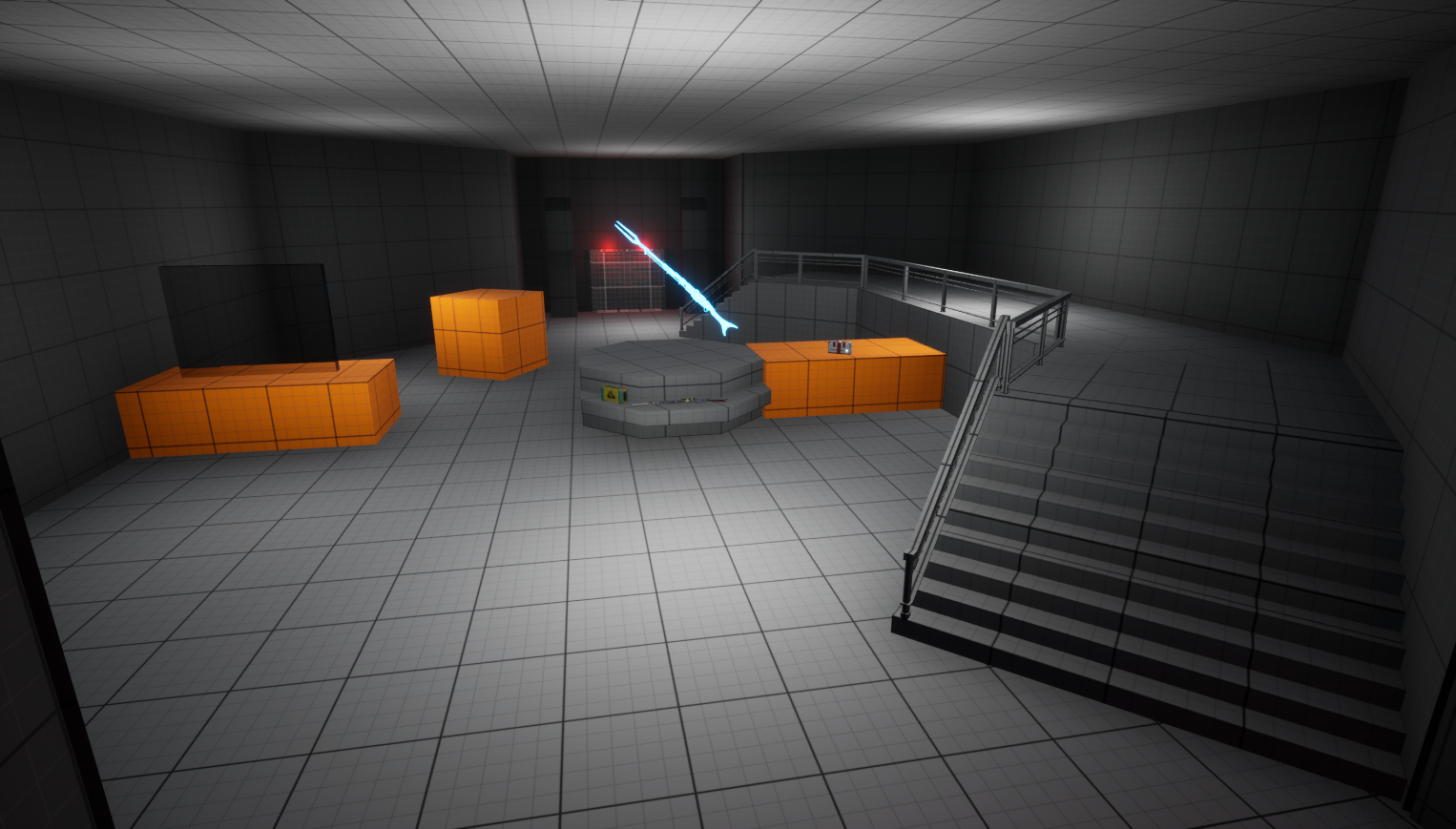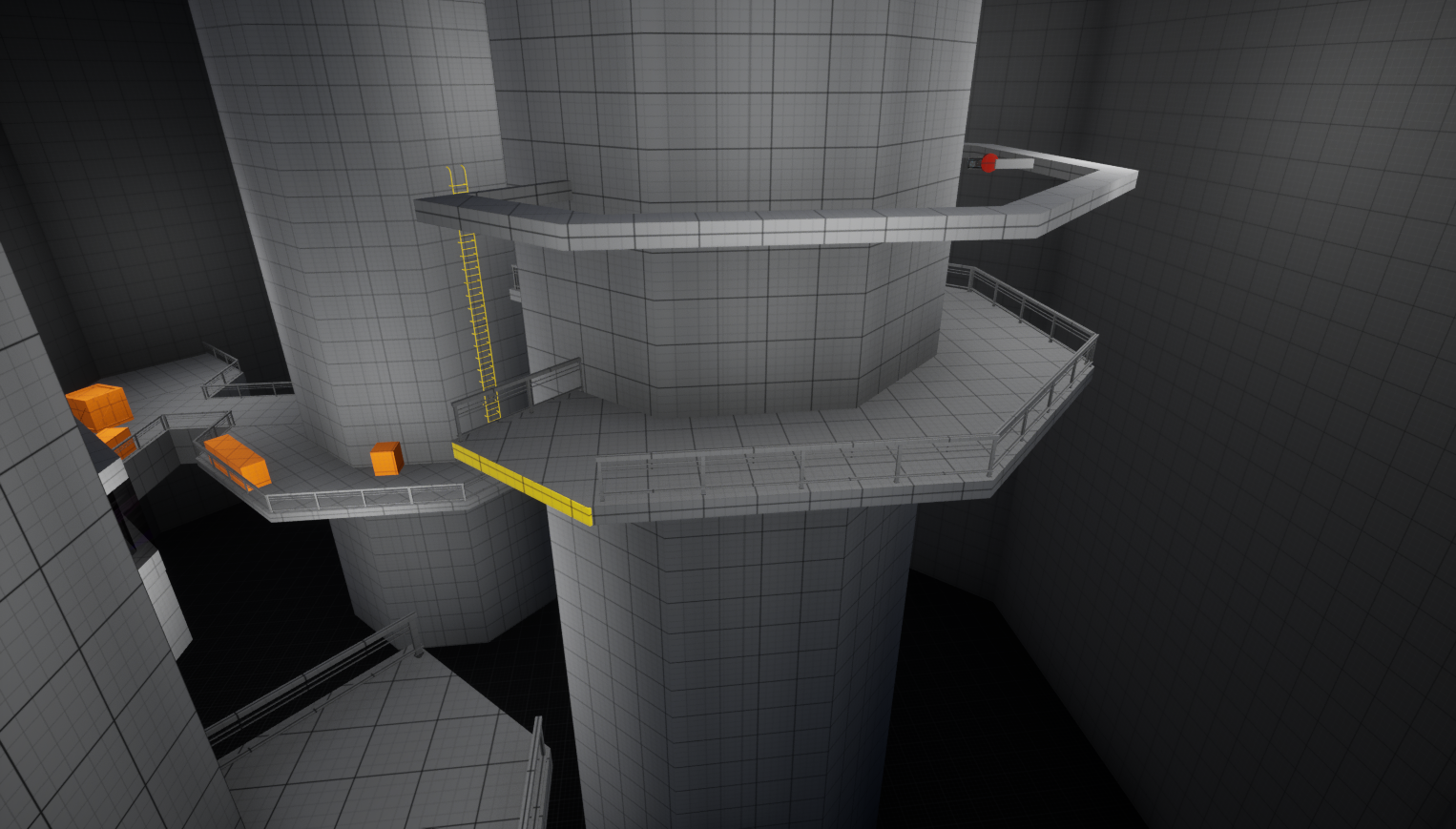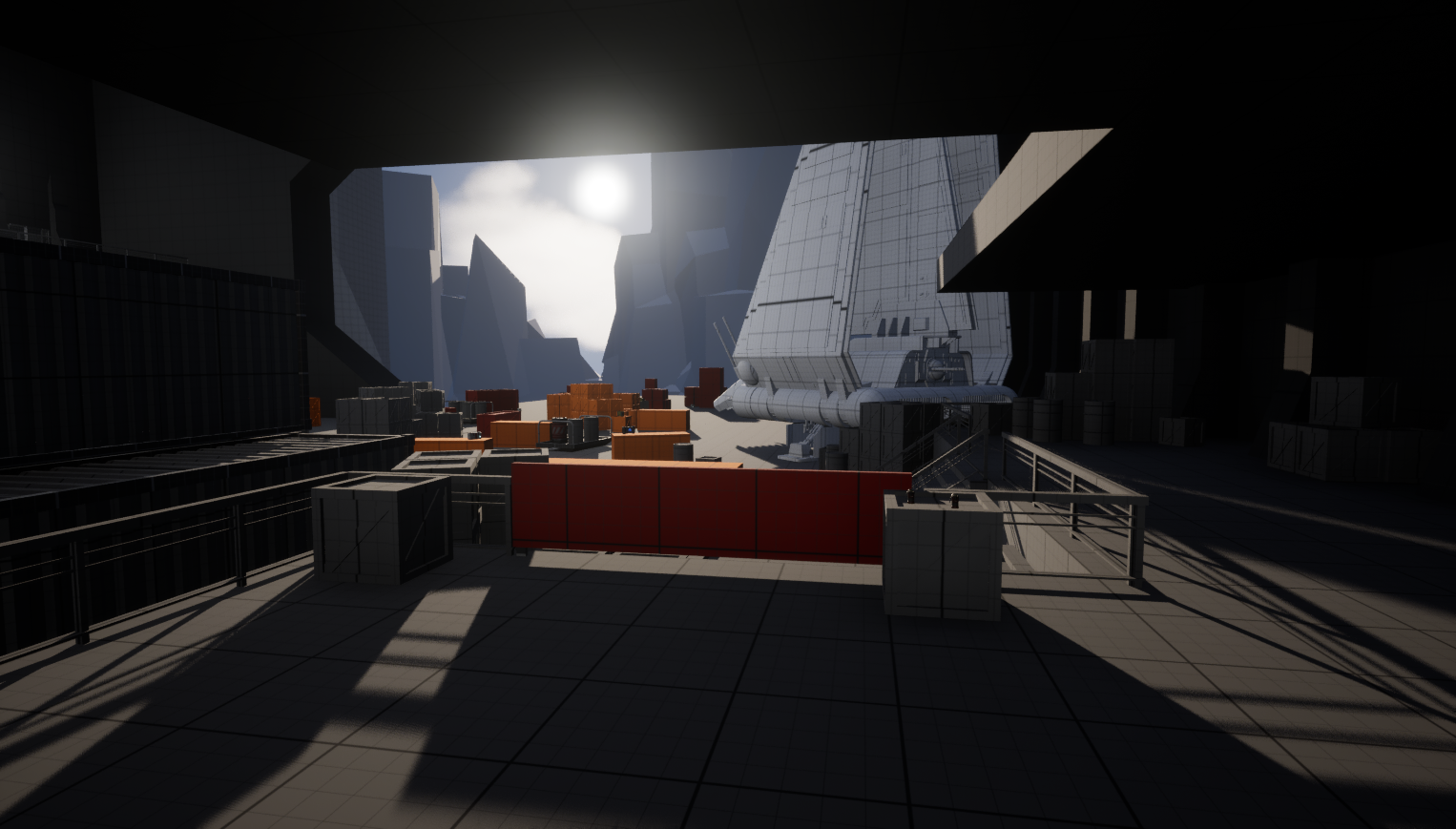
Personal Project - Unreal Engine
The Mandalorian - Ghost Forge
Created over the course of 5 weeks, this project is a high octane, narratively-driven level that tells a complete story arc through exciting gameplay, unique interactions, scripting and dialogue. Inspired by Star Wars 1313, it mixes both careful stealth and guns-blazing combat gameplay.
Summary
The Mandalorian Clans have heard rumors of the Empire developing new anti-beskar technology. Din Djarin is sent to sabotage a Galactic Empire weapons research facility. He must make sure that the Empire stops developing these new weapons.
Intentions
Showcase Mission Design, Scripting, Layout, Stealth and Combat Space Design skills
Create accurate spaces that sell the Star Wars fantasy while enabling fun, rewarding gameplay
Script exotic sequences that tell the story and create unique, memorable moments in the level
Design an exciting boss fight at the end of the level
Practice stealth vs combat layout design
Tell a story through gameplay, architecture, cutscenes, exotic sequences and dialogue
Constraints
Unreal Engine 5
Third Person Shooter Kit (Character Controller & AI)
Start from the story beats and design gameplay from that framework instead of gameplay-first (Challenged by mentor)
+- 15 minutes of gameplay
Level must have a start, middle, end point and have a clear sense of progression
Documentation
Miro Board
Pacing & Intensity Graph
Top Down 2D Layout
Gameplay Beats
Beat #1
First Steps
The first part of the level is aimed towards stealth and traversal while setting the scene for the narrative of the level. Lighting and color coding was used to navigate the player to the entry towards the next room. I also added a level sequence camera cut that focused on the exit to rapidly emphasize the destination to the player.
Intensity : 0/10
Beat #2
The Reactor Room
As the player enters the room, I frame both the destination and the way to unlock it : the moveable staircase that is activated by a control panel. The initial vista point also gives them time to analyze and understand the layout as well as the patrol path of the enemy.
Intensity : 3/10
Beat #3
Security Checkpoint
This beat serves as a transition point before the next high intensity section of the level. The goal was to make players practice and learn more complex behaviours of the enemies. First, the player is forced to stealth around an invulnerable turret to perform a hacking mini game. Then, they encounter a tight cover layout including two stormtroopers at once where they have to perfectly time their stealth movement.
Intensity : 4/10
Beat #4
Weapon Labs
As the player enters the room, an ongoing level sequence is triggered. I wanted to use this room to communicate the story and importance of what the player is doing narratively. This layout was designed to confront more enemies in the same space, while also making the patrol paths more forgiving. This created a rewarding stealth sequence where if the player sneaks into the test room undetected they can hack the turret to turn it against the Imperials.
Intensity : 6/10
Beat #5
Navigating the Corridors
Rewarding the player with a strong weapon after an intense encounter, the intention was to surprise them with enemies, forcing them to test the new weapon’s efficiency. After that, the next corridor section was built to practice the mastery of the turret’s behaviour, while being a navigational/downpace beat in terms of intensity.
Intensity : 4/10
Beat #6
Reaching the Data Vault
Initially presenting the player with a vantage point that frames important locations for the rest of the level, this beat serves as a breather for the player before the upcoming much more intense section. They can restock on resources, but also take in the view and the space allows for full immersion in the Star Wars fantasy.
Intensity : 1/10
Beat #7
Obtaining the Vault Access Codes
After reaching the locked Data Vault door, the player must navigate to the Command Center, which is designed as a very tight, cover-to-cover stealth layout. This particular section was built to test the player’s stealth skills. I added a singular Stormtrooper patrol at the edge of the room that overlooks three other patrols, making the player’s timing crucial. To limit frustration I also shaped the geometry of the level so that backtracking to the entry from the Command Table is very quick and frictionless.
Intensity : 6/10
Beat #8
Retrieving the Anti-Beskar Schematics
After unlocking the room, a Level Sequence presents the player with their next objective : climb up the Data Towers. This beat was designed as a navigational challenge, so that it contrasts with the rest of the mostly stealth/combat challenged based mission, while using a call-back to the mesh destruction mechanics used earlier in the level.
Intensity : 3/10
Beat #9
Escaping to the Main Hangar
Once the player retrieves the Schematics, hell breaks loose in the level. This section was designed to be an immediate, surprising spike in intensity, driving the player constantly forwards toward the hangar. This sequence required a lot of scripting and it was a fun challenge. With added SFX, VFX, lighting and enemies swarming the player, the intensity ramps up very rapidly. During the last encounter in the Hangar, the intention was to strongly encourage the player to move cover-to-cover as they progressed through the stormtroopers.
Intensity : 8/10
Beat #10
Defeating the TIE Fighter Boss
As a grand finale, I wanted to design a bossfight that really had that epic “Star Wars feel”. Using destructible cover and a rotating spline around the boss area, this exciting encounter forces the player to be constantly on their toes and test their mastery of the Amban Rifle, the powerful new weapon previously acquired in the level. As the fight progresses, there is less and less safe covers, making the stakes constantly higher.
Intensity : 10/10
Level Design Techniques
Framing - Across the level, one of my biggest priorities was to make sure that the objective / way to the objective was clearly framed through composition, vantage point and/or lighting contrast. By placing POV cameras in the editor at each room entry, I was able to easily iterate on composition and geometry to guide the player’s eye.
Lighting to create emotions - After the initial rounds of feedback, I realized that the whole ending sequence was missing intensity and a sense of urgency for the player to run out of the facility towards the Hangar. I changed the lighting to switch to red while also playing an alarm sound once the player started the escape sequence. This proved to be much more effective at creating the emotion I wanted out of the player.
Using animation/props to guide the player - In this particular three-way corridor, I wanted to make sure to guide the player to the right door without frustration. I felt like this was a great moment to lean into the Star Wars theme and add a mouse droid that is often found in Imperial Bases. It allowed me to subtly draw the player in the right direction.
Key Design Iterations
Hangar Combat Space
After the initial round of feedback, I realized that the initial cover spot out of the gate once the player entered the hangar was too strong. This went against my intention of making the player advance and fight their way through the combat space. There was too much good cover, a good line of sight towards the enemies, it was easily reachable and just overall gave no reason to move.
I solved this problem with three changes. First, I moved the enemies and their cover layout closer to where the player entered the space. This made accessing this cover for the player much easier, while also making the enemies more menacing and accurate.
Second, I removed the hard cover initially placed at the entrance and replaced it with a single destructible cover. This proved efficient in three ways : it surprised the player, it taught that certain covers could be destroyed, and forced the player to move forward to the enemies, where the only available cover was. Lastly, I removed the health and ammo pickups at that initial cover to make it even less enticing to stay there.
Initial Design
Turret Introduction
Initially, the Turret was introduced in the Security room. I found it to be a very harsh introduction since it had both a new “detection cone” mechanic as well as an invulnerability shield. I decided to iterate on the first area (Reactor Room) and replace the 2nd Stormtrooper guard by a vulnerable turret, while offering generous cover to the player so that it is a safe teach. This proved to make the progression from Reactor Room to Security Room much more smooth and gradual in terms of intensity.
Initial Design
Final Design
Final Design
TIE Fighter (Gameplay Space & Boss Design)
Initially, the TIE Fighter Boss was static and the player simply had to move around the space to pick up ammo and shoot it down. This made the boss much less exciting than what I wanted this sequence to be : a grand finale.
I improved this gameplay sequence in two ways : both with the boss design itself and the encounter space. First, I created a spline BP on which the boss would fly, making it fly around the landing dock. This made the player have to track the boss and time their weapon correctly, since it is a projectile weapon. This also made the dodging of the boss’ attacks harder, making the player move around the layout for another reason than just picking up ammo.
I wanted the player to have to “react” to the boss and adapt their movement to their attacks and plan their route accordingly. Therefore, I added cover, but made all of it destructible by the boss’ attacks. This made it so that the player had to constantly rotate around the covers while also managing the boss’ position and shooting line
Initial Design
Adding a Guidance element with an Objective Tracker UI
Even if there was a clear dialogue cue as well as visual framing/guidance for every objective, I wanted to really nail the clarity of what the player had to do next in the level. Therefore I scripted a blueprint widget that tracked the player’s objectives through both triggers in the editor space but also with Event Dispatchers that could update the Game Mode with a new objective.
Final Design




























